CHAPTER 04
Events That Shook the World
THE NIGHT SKY IS AN EVER-CHANGING DISPLAY OF MOST IMPRESSIVE NATURAL PHENOMENA
In our day-to-day existence, few of us take the time to contemplate the very dynamic nature of the night sky, or to consider that this natural theatre might be screening more than one film over and over again. To many of us, the naked-eye view of our galaxy does not seem to change at all in the lifetime of a human being but, in fact, countless celestial events are happening within our solar system all of the time.
These are the events that draw stargazers across the world to gather and bear witness. Every time there is a total solar eclipse, thousands of people travel to where the moon shadow travels across the Earth’s surface. Something deep inside of us is touched during these brief moments of totality. We understand the physics and geometry of the phenomenon, but when viewed for the first time it can stir almost primeval instincts within us, leaving us in awe of the natural takeover of this event. It can be an incredibly emotional experience. While this phenomenon appears to be repeating in the same shape, each one of its daytime nights is utterly unique, depending on how the immediate environment reacts to the mysterious darkness of totality that can last anywhere from one second to seven minutes. Beyond their dramatic day-to-night shift and scientific importance, eclipses have also made a cultural impact in their time, seen by past civilizations as a warning from the gods. Even today, these irregular events remain a powerful and connecting experience. Eclipse-chasers from a multitude of cultures and beliefs come together under the lunar shadow and are united through a common passion.

Black Forest GERMANY
This bright streak is a fireball from a Leonid meteor shower, flashing through a clear predawn November sky and seen from a high-altitude vista above an ocean of low cloud. Sirius and stars of constellation Orion (the Hunter) are about to disappear on the western horizon.
One of the most spectacular scenes in a dark night sky – one that rivals the beauty of the Milky Way, even – is the appearance of a great comet. Seeing its extended tailburn across the sky makes for a truly memorable experience. The most impressive in recent history was the incredibly vivid Comet Hale-Bopp in 1997, visible even from metropolitan areas. In more rural locations, it was the most unusual sight, with both the dust and ion tails distinctively visible, and appearing many times larger than the moon. The comet’s icy nucleus measured roughly 50 km (30 miles) in diameter and had a lower light density than water, but the comet’s tail, although consisting of very little mass, extended further than 100 million km (62 million miles) into the solar system – two-thirds of the distance from Earth to the sun. This made it visible from almost 200 million km (124 million miles) away during its closest approach to our planet. In 2007 and 2011, Comets McNaught and Lovejoy made history with their extraordinary appearances in the southern hemisphere sky. On average one great comet appears in the Earth sky per decade, when one of these small icy visitors from the outer solar system makes a close approach to the sun and the Earth. Not all sightings are as bright as the great comets, and so many are not visible to the naked eye. Thankfully, they can be captured using long-exposure photographs, such as a few of the images in this chapter, which also illustrates majestic comets seen in both hemispheres.
The celestial world does provide some known quantities. Comet debris around the sun generates meteor showers when the Earth passes through its streams. These repeat throughout the year, almost always at the same times. Casual stargazers have a few favourites among them, in particular the Geminids in mid-December and the Perseids in August. The most amazing are the occasional meteor storms of Leonids in November. About every three decades, when the parent comet of this stream returns to the sun, this usually poor meteor shower becomes a roaring monster, with thousands of meteors in just a few hours of peak activity. In recent decades, some of the most memorable Leonid storms occurred from 1998 to 2002. During this time, countless fireballs (bright meteors) and thousands of meteors would burst into the sky in a single night with a sharp peak lasting one or two hours. The next Leonid storm is expected in early 2030s.
Other notable sky events include massive aurora storms, especially during periods of maximum solar activity, which make the lights easily visible in latitudes far from the polar regions. In October 2003, a massive solar eruption occurred directly facing Earth. Our planet experienced a geomagnetic storm that caused spacecrafts and satellites to malfunction and red aurorae were observed over the northern horizon as far south as Greece, Southern California, Texas and even Florida.
Close conjunction of the moon and planets or between the planets themselves also makes the news. A very close conjunction of Venus and Jupiter in the year 2 [BCE] is possibly the origin for the Star of Bethlehem, with the two dazzling planets being so close that they appeared to merge into a single object. Seeing such close alignment today, on a clear and bright night sky, almost allows you to imagine how the great ‘star’ was seen.
As the photographs in this chapter will testify, the night sky is an ever-changing display of the most impressive natural phenomena.
ECLIPSES
Creating the most beautiful ‘diamond ring’ – when the faint glow of the sun’s corona begins to appear around the black disc of the moon, with a bright sparkle in just one spot – the last rays of the sun disappear to leave a sudden midday darkness. Birds fly to their nests, insects jump out to celebrate the brief night and bizarre twilight colours and shades shift along the horizon. These tantalizing moments can hook anyone – eclipse-chasers are often referred to as addicts – and it makes for a unique form of travel to head to the place where the moon’s shadow touches the Earth during a total solar eclipse.
The moon’s shadow is typically more than 15,000 km (9,300 miles) long and around 100–200 km (60–125 miles) wide. It covers less than 1 per cent of Earth’s surface and usually falls across more sea than land. Outside of the area – and up to 3,000 km (1,900 miles) – people will still be able to witness a partial eclipse in the moon’s penumbral shadow. Only during a full eclipse, when it is totally safe to remove any solar protection and enjoy the scene with the naked eye, do the solar corona and red prominences become easily visible, forming the ‘diamond ring’ that marks the beginning and end of totality. The brightest stars and planets become visible at this time, the temperature drops and a sudden wind manifests, and all of nature reacts to this most spectacular natural phenomenon. During a total lunar eclipse (when Earth passes between the sun and the moon), people in the half of the planet that faces the moon will see it dim to a red colour as it falls within Earth’s shadow.
Solar eclipses occur more frequently than lunar eclipses. On average a total solar eclipse takes place somewhere on Earth every one and a half years, while lunar eclipses are slightly less frequent. But for those who don’t travel, totality is a once in a lifetime experience. On average, a single location will experience a total solar eclipse once every 375 years.

Ternate INDONESIA
An eclipsed sun hangs in a clearing sky over Ternate, Indonesia, during the total solar eclipse of 9 March 2016. In this close-up image, the sun’s elusive outermost layers – known collectively as its corona – illuminate the clouds. At this stage of the eclipse, with the solar disc blacked out, the brightness of the corona is similar to that of a full moon.

Lofoten Islands NORWAY
This composite image shows various phases of the partial lunar eclipse of 31 January 2018, each shot taken using a telephoto lens and about five minutes apart. The camera setting was fixed during the sequence, and captures the changing light during the eclipse. In the foreground are the coastal mountains of Myrland, in the central area of the Lofoten Islands, inside the Arctic Circle at 68 degrees north.

Isfahan IRAN
The lunar eclipse of 10 December 2011 is captured here at total phase, with the moon rising at dusk over the Zagros Mountains. The moon does not completely disappear as it passes through Earth’s shadow because the Earth’s atmosphere refracts the sunlight, allowing some indirect light to reach the moon. If the Earth had no atmosphere, the moon would go completely dark.

Wyoming USA
The Great American Eclipse of 21 August 2017 is so-called because it was visible in a band that spanned the United States from the Pacific to the Atlantic. Here it is captured above a twisted pine, in a shot taken from a high-altitude vantage point. The wide-angle view shows the full extent of the solar corona, only visible when the much brighter solar surface is masked and the background sky is darkened. It would seem logical for the sun’s outer layers to cool down in space, but in fact the opposite is true. While the temperature is around 6,000°C (10,800°F) on the solar surface, it rises sharply to a few million degrees in the corona and astronomers have not yet discovered why.
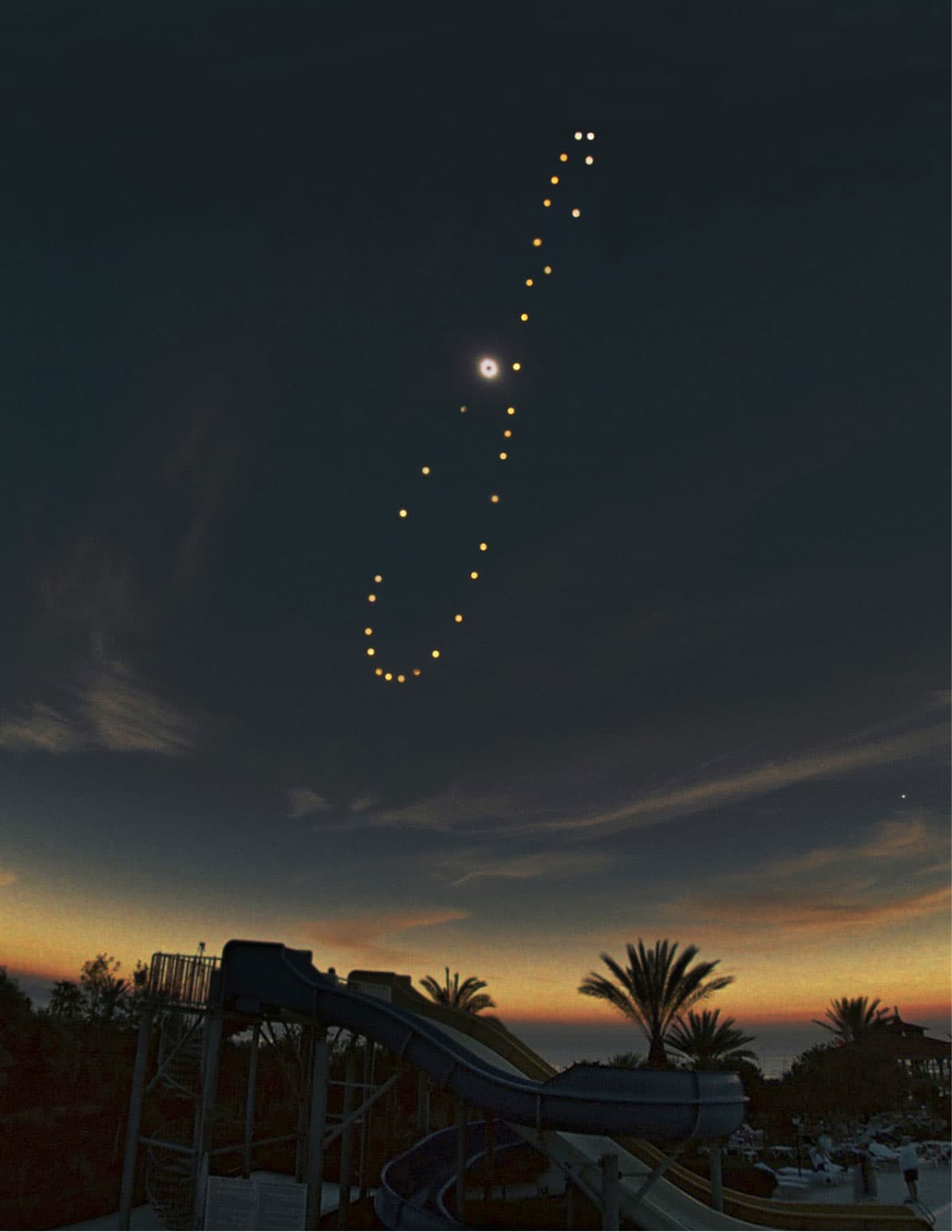
Antalya TURKEY
An analemma image involves photographing the sun from exactly the same location, and at exactly the same time of day, twice a month. The shots are then assembled in a composite image, to show how the sun’s position in the sky changes as the year progresses. The image here is thought to be the world’s first analemma image that also includes a total solar eclipse. This particular composite image shows the sun’s motion in one frame, with photos taken every ten to fourteen days, including the eclipse of 29 March 2006. The eclipsed sun appears brighter because it is the only shot taken without a solar filter and for a longer exposure time. The photograph is dubbed ‘Tutulemma’ – a play on the Turkish word for eclipse (tutulma), and ‘analemma’.
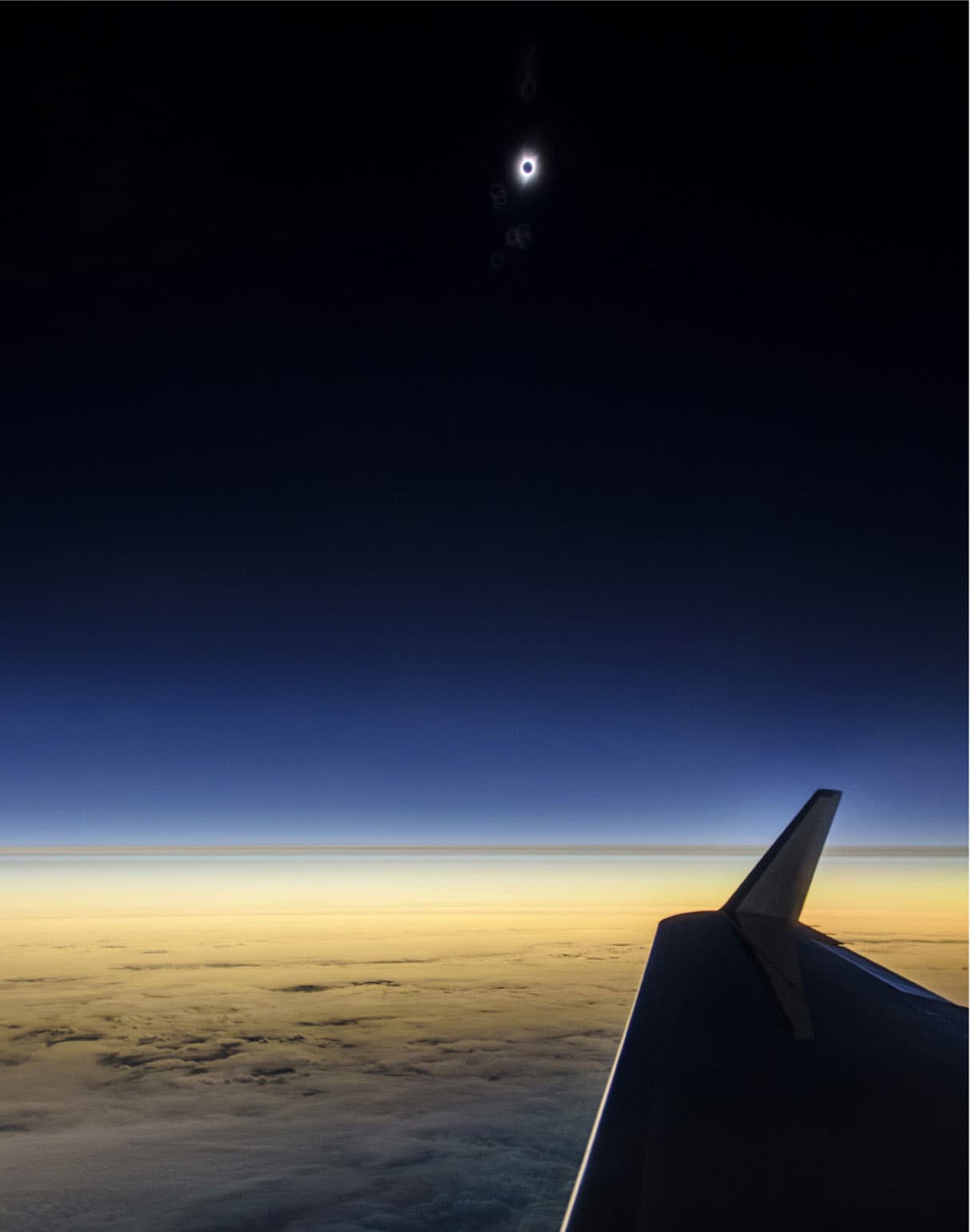
PACIFIC OCEAN
The 21 August 2017 totality, captured while flying 13,700 m (45,000 ft) above the cloud-covered Pacific Ocean, on the edge of the stratosphere, some 400 km (250 miles) off the west coast of Oregon, USA. Taken from onboard a small jet aeroplane, this was the first image of the Great American Eclipse to be taken before it hit the coast and travelled across the United States. The horizon colours are surreal, but more notable at such a high altitude is the pitch-black sky that almost conjures the feeling of flying in space.

Alqueva PORTUGAL
Mars (lower trajectory) appears close to the moon in this time-lapse sequence of the longest total lunar eclipse of the century, which occured on 27 July 2018. The sequence begins close to moonrise, with the moon in total eclipse phase, and progresses from dark red to bright orange. As time passes, the sequence then continues through partial eclipse phases until the return of brilliant silver moonlight. Sunlight, refracted by Earth’s atmosphere, is the source of the dim red light on the moon during lunar eclipses. Dust and gases in the atmosphere scatter blue wavelengths from sunlight, leaving the remaining light reddened.

Tehran IRAN
During one of the darkest lunar eclipses of our time, the red eclipsed moon is captured against the galactic centre – the heart of the Milky Way – in a single-exposure photograph of just forty seconds. The photograph was taken from the Alborz Mountains near Tehran, on 15 June 2011. The moon lies just above the bowl of the dark Pipe Nebula, to the right of the glowing Lagoon and Trifid nebulae and the central Milky Way dust clouds. To the far right, the wide field is anchored by yellow Antares in the constellation of Scorpius (the Scorpion) and the colourful clouds of the star system Rho Ophiuchi.

Las Campanas CHILE
This panoramic view shows the setting Milky Way band and neighbouring satellite galaxies, the Magellanic Clouds (left), in the southern sky, hanging over the twin Magellan Telescopes at Las Campanas Observatory, during the total lunar eclipse of 27 September 2015. What had been a bright, star-free, full-moon sky just hours before this scene, has changed dramatically into a totally dark night that lasts a full hour during the total eclipse. The image is a high-dynamic-range (HDR) composite that uses two exposures – a shorter one to reveal the eclipsed moon details and a longer one to capture the much darker background sky.
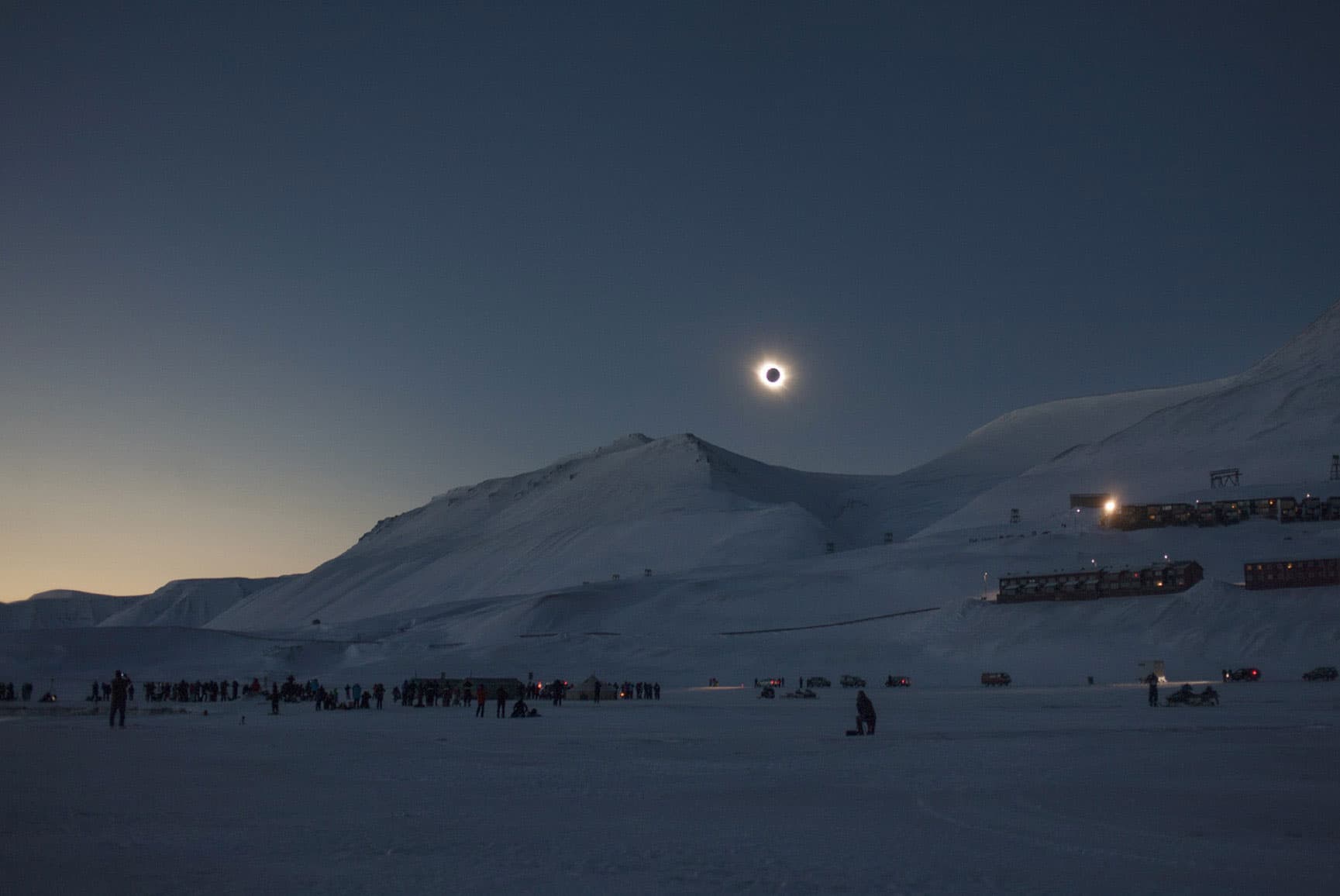
Svalbard NORWAY
The Arctic total solar eclipse of 20 March 2015 occurred on the vernal equinox that marks the beginning of spring. This image was taken just 1,000 km (600 miles) from the North Pole, at 78 degrees north, in Svalbard, with the eclipse hanging low on the southern horizon over the high hills that hug the settlement of Longyearbyen. The daytime temperature was –20°C (–4°F) and dropped lower during the totality.

Queensland AUSTRALIA
Photographed above Australia’s northern coastline on the morning of 14 November 2012, storm clouds threatened to spoil the view of this eclipse, but the clouds parted minutes before totality. The area was plunged into darkness for two minutes as the moon’s shadow swept offshore towards the Great Barrier Reef and out into the South Pacific Ocean. Streaming past the moon’s edge, the last direct rays of sunlight produced a gorgeous diamond-ring effect. Ranging from 1/4000 to 1/15 seconds long, five exposures were blended to create a presentation similar to the breathtaking visual experience of the eclipse.

Ternate INDONESIA
A dark sun hangs in a clearing sky in this sea- and skyscape, during the total solar eclipse of 9 March 2016, somewhere along the narrow path of totality where the moon shadow touches the Earth’s surface. Ternate and a chain of other volcanic islands in North Maluku lie in the foreground. The sky is still bright near the eastern horizon, outside the moon’s umbral shadow. In fact, near the equator the dark lunar umbra rushes eastward across Earth’s surface at about 1,700 km (1,100 miles) per hour – faster than it travels at high latitudes because of the larger circular diameter of the Earth surface in the tropics and hence more rapid surface rotation. Shining through the thin clouds, around the sun’s silhouette is the alluring glow of the solar corona.
COMETS
Many millions of comets exist in the outer solar system – beyond Neptune in the Kuiper Belt, for example, and in a spherical cloud of icy bodies known as the Oort Cloud, which extends out from the Kuiper Belt to an incredible distance of almost two light years away – halfway to the next star in the galaxy. Comets travel on elongated elliptical orbits. When one approaches close enough to the sun and Earth, it becomes a magnificent sight. Moving slowly across the sky over a succession of nights, a comet develops a tail and sudden eruptions burst out from the icy nucleus, changing the brightness of the comet’s coma – the nebulous layer that surrounds the nucleus. Today we know that these wandering icebergs are fossils of the solar system’s formation some 4.5 billion years ago. Like rocky asteroids, they became some of the first solid bodies to orbit the newborn sun, and are mainly formed of dusty ice, not only containing frozen water, but also frozen carbon dioxide, carbon monoxide, methane and ammonia. At that time, comets and asteroids were not confined to certain zones. During the years of the chaotic young solar system, comets and asteroids constantly battered the newly formed planets; some studies suggest that this is how Earth’s oceans formed.
Today, one or two naked-eye comets appear in Earth’s sky per year on average, reaching magnitudes of 4 to 5. Usually barely visible to inexperienced eyes, these are often majestic in long-exposure telescopic images. Sometimes, an eruption at the comet nucleus exposes otherwise concealed ice to sunlight, suddenly increasing the comet’s brightness with a larger coma or longer tail. If a comet passes a magnitude scale of 2 to 3, it could be considered a Great Comet as it approaches Earth and the sun.
Before the eighteenth century, little was known about the nature of comets and they were often considered bad omens – forewarnings of death, catastrophe or an attack from heavenly beings. Most astronomers considered them to be atmospheric phenomena. It was in the late sixteenth century that Danish pre-telescope astronomer Tycho Brahe proved comets must exist in outer space, by measuring the parallax of the Great Comet of 1577 from observations collected by geographically separated observers. In 1705, British astronomer Edmond Halley was the first to prove that some comets return periodically, and he predicted Comet Halley’s return to the inner solar system to be every seventy-five to seventy-six years. We now know that this comet has been observed since at least 240 [BCE], its presence having been recorded by Chinese and Babylonian astronomers. Comet Halley’s next return will be in 2061, but we don’t have to wait until then to witness the next great comet in Earth’s sky. On average, a bright comet hits our skies every decade and some of the most recent and majestic appearances are showcased in the pages that follow.

Andes CHILE
Rising at the break of dawn, Comet Lovejoy (C/2011 W3) is photographed using a star-tracker mount for a longer exposure. The mount tracks stars, cancelling the movement of the sky that results from Earth’s rotation. The effect is to make the foreground move instead, appearing blurred and lending a fine-art, abstract look to the resulting image. The comet is rising here in the morning twilight.

California USA
Captured in this image are the exceptionally long tail of Comet Hyakutake and a faint meteor. Hyakutake passed very close to Earth in March 1996. One of the closest cometary approaches of the previous 200 years, the event took place less than two months after the comet’s discovery. Rapidly approaching the sun, the comet grew an ion tail so large that it was visible extended across the sky up to 90 degrees in the darkest night skies – that’s like saying that, if the comet head was on the horizon, the end of the tail would be directly overhead.

Réunion SOUTH INDIAN OCEAN
Comet Lovejoy (C/2011 W3) appears at dawn, in the southern hemisphere sky above Réunion Island. The light cone to the left of the comet is caused by zodiacal light above the Cirque de Mafate caldera, partially covered by low cloud. Known as a sungrazer, Lovejoy was just 185,000 km (115,000 miles) at perihelion – the point at which its orbit was closest to the sun. These comets do not usually survive such a close approach to the sun and Lovejoy lost a lot of its icy body, leading to the bizarre headless form seen here, in comparison to the bright concentrated head of Comet Hyakutake (opposite).

Cerro Paranal CHILE
Many comets that become visible to the naked eye are small, fuzzy objects unless photographed through a telescope. In this rare sight, two comets are visible in the same part of the sky above the Atacama Desert in Chile. The Large and Small Magellanic Clouds are above the European Southern Observatory site at Cerro Paranal. The small comets can be seen to the right of the image, in the morning twilight: PanSTARRS (C/2011 L4) on the horizon and Lemmon (C/2012 F6) higher up.

Western Australia AUSTRALIA
In January 2007, Comet McNaught (C/2006 P1) became the brightest comet in four decades, reaching a magnitude of –5 and surpassing even Venus in brightness. In the northern hemisphere the comet was only visible close to the sun, and with a little tail barely visible in the twilight glow on the horizon. As its orbit took the comet away from the sun, it emerged out of the evening twilight in the southern hemisphere, to present a spectacular view, as captured here, above a small observatory.

Victoria AUSTRALIA
The elegant tail of Comet Lovejoy (C/2011 W3) is captured in the morning sky above Cape Schanck, 90 km (56 miles) from Melbourne. The 200 m (660 ft) icy body not only survived its close perihelion – but in the days that followed, it held together and reformed its dust and gas tails.

Lake Balaton HUNGARY
Reaching a magnitude of 4, Comet PanSTARRS (C/2011 L4) was easily visible to the naked eye in this clear twilight sky, but only as a small, elongated patch of light.

FINLAND
This telephoto view captures an unusual alignment of Comet PanSTARRS (C/2011 L4) and the Andromeda Galaxy (M31). Similar in brightness and visible to the naked eye, one is a small mountain of ice in our solar system, while the other is a cosmic island with a trillion stars. Larger than the Milky Way, the Andromeda Galaxy is about 2.5 million light years away.

FINLAND
Comet Hale-Bopp appeared at its brightest in April 1997, pictured here with a beautiful, separate blue ion (gas) tail as well as its white dust tail, against a backdrop of constellation Perseus. It was discovered by two American astronomers, independently from one another and on the same night in July 1995. The two men, Alan Hale and Thomas Bopp, could not have imagined that the faint halo they observed through their telescopes would go on to become worldwide news.
METEOR SHOWERS
On any moonless night, a keen observer might see a meteor every ten minutes on average, especially towards morning. These sporadic meteors are random wandering meteoroids – fragments of rock or ice – that enter Earth’s atmosphere at very high speeds ranging from 11–72 km/sec (25,000–160,000 mph). On certain days of the year, our planet passes streams of debris created by comets, where particles left behind the comet tail and coma continue to follow the comet’s path around the sun. On these nights, the number of meteors increases several times. While these meteor showers repeat annually, almost on the same night, the predicted peak varies by several hours each year, depending on which part of the world is facing the stream at the time. Such displays also depend on the moon phase. The faintest meteors will not be visible on a night with a full moon. Light pollution also reduces visibility.
The most popular meteor showers, seen in both hemispheres, are the Perseids, which peak on 12–13 August and the Geminids on 14–15 December. Showers are active from around one week before they peak and continue for up to a week after, but at much lower rates. During peak activity, the rate of visible meteors reaches 100 or more per hour. The Leonids, in November, are the most spectacular meteor showers, but they only become notably active every three decades, when the parent comet (Tempel-Tuttle) returns to the inner solar system and enriches the stream. The Leonids displayed spectacular meteor storms from 1998 to 2002 and such a display is expected again in the 2030s. During one of these storms, in 1966, the rate of the shower reached an incredible 1,000 meteors per minute.
The brilliant flash of light from a meteor is not caused so much by its mass, but is a result of the high kinetic energy generated by the speed. Most visible meteors are dimmer and do not create meteorites – rocks that fall to Earth. They are caused by particles about the size of a small pebble down to a grain of sand and weigh less than 1–2 grams. Fireballs, on the other hand, are generated by tennis-ball-sized meteoroids and may reach the ground in the form of a small rock, depending on its composition (ice, metal or rock). Around 10,000 tonnes of this material falls to Earth each year, ranging in size from small rocks to micrometeorite dust.
In the southern hemisphere and the tropics, the Eta Aquariid meteor shower from 6–7 May has notable activity that can reach sixty meteors per hour. In northern latitudes, the Quadrantid meteor shower has a rich display of up to 100 meteors per hour on 3-4 January. However, the shower’s short, sharp peak is only visible from certain longitudes, reaching a particular high just before dawn as the shower’s radiant, close to the handle of the Big Dipper, rises high in the sky. In any meteor shower the radiant is the area of sky to which the backward motion of a meteor points.

Lofoten Islands NORWAY
A rarity, this photograph captures a fireball and the bright aurora borealis in one frame. The bright star Capella is to the right of the image and the constellation Gemini (the Twins) are below the meteor. According to the American Meteor Society, even experienced observers can expect to see just one fireball of this brightness (magnitude –6) in every 200 hours of observation. Brighter fireballs are an incredibly rare spot and even less likely to be photographed.

Alsace FRANCE
In this circular fisheye image, a dazzling green light crosses the sky from east to west, five hours before the peak of the Leonid meteor shower on 18 November 2012. Most meteors are sub-second flashes of light, but these Earthgrazers take several seconds to cross the entire sky as they graze Earth’s atmosphere instead of falling down towards the planet. They often occur at the beginning of the night before the shower’s radiant constellation rises in the sky. Green is the most common colour, but they also appear in yellow-red, bright blue and, rarely, violet. The velocity and dominant composition of a meteoroid plays a part in the observed colours. For example, vaporized sodium from the object produces a bright-yellow colour, nickel shows as green and magnesium as blue-white. The excited atoms in the atmosphere along the path of the meteor glow as well.
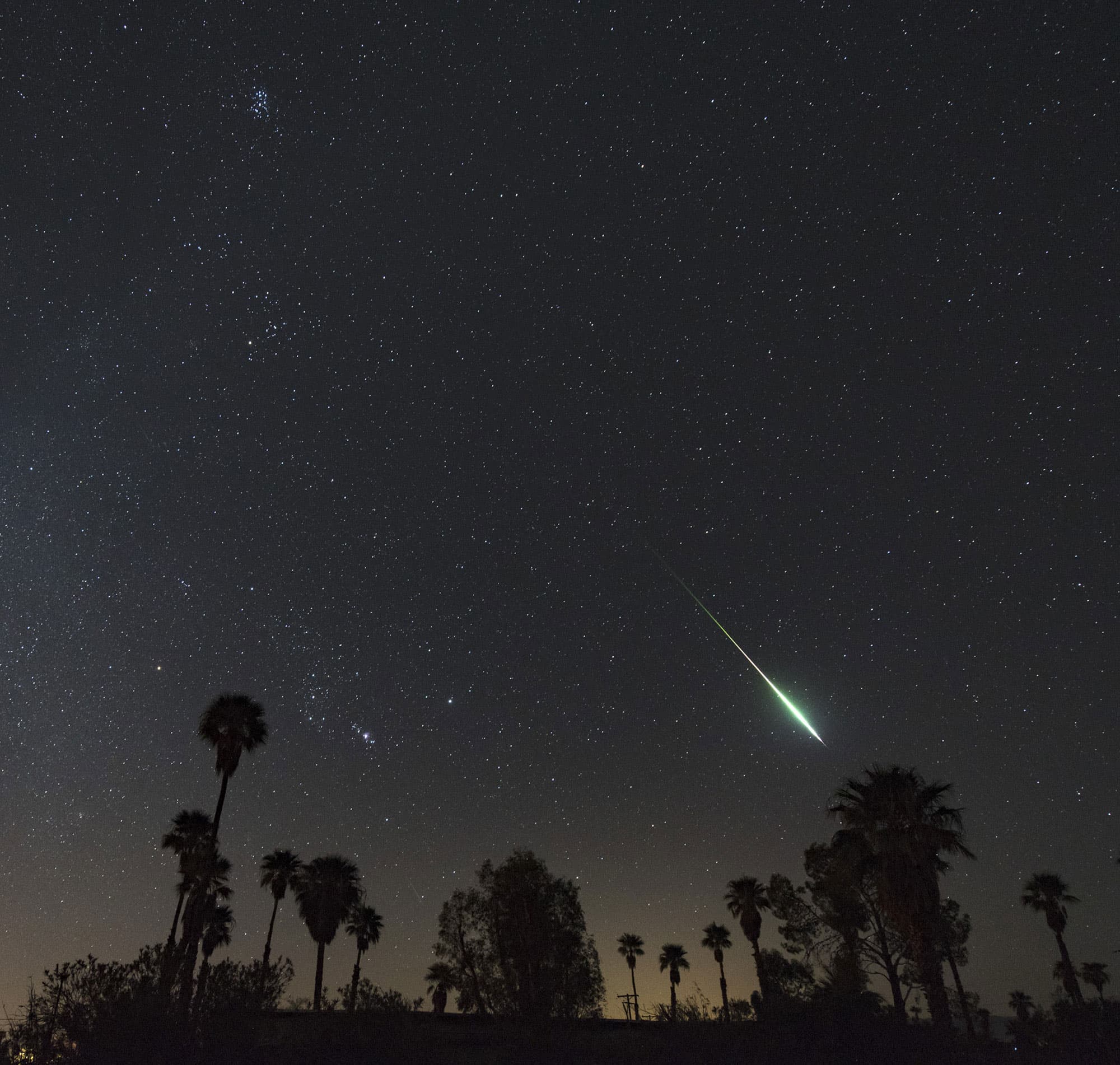
California USA
A fireball flashes in the sky during the Perseid meteor shower of August 2016. Photographed in the Anza-Borrego Desert State Park, this is just one photograph from more than 1,700 frames in a time-lapse sequence. Fireballs are meteors that burn more brightly than planet Venus, which is the brightest object in the night sky after the moon. On the astronomical magnitude scale they are brighter than –4, but they are rare.

California USA
The Leonids meteor storm of November 2001 bursts over Joshua Tree National Park. This single exposure of twenty seconds on film has captured six green meteors in the small field of view of a 50 mm lens, highlighting constellation Canis Major (the Big Dog) and its bright star Sirius. The meteors come from sand-sized particles ejected from Comet Tempel-Tuttle during trips to the inner solar system.

Semnan IRAN
On 17 November 1998, an unexpected Leonid meteor storm filled the sky a night before its predicted peak, displaying many dazzling fireballs. The Earth passed through a dense stream from the storm’s parent comet, rich in larger debris and, therefore, brighter meteors. In this single exposure of twenty minutes on film, seventeen meteors are captured over the historic Caravanserai of Deh Namak along the ancient Silk Road in Iran.

California USA
This cosmic sword of Orion (the Hunter) is an amazingly bright fireball, as captured during the December 2009 Geminid meteor shower. As bright as the full moon, such a meteor is known as a bollide. This dramatic view, taken from the Hercules Finger rock formation in the Mojave Desert of the southwestern United States includes the setting prominent winter stars from the dazzling Sirius (left) to constellations Orion and Taurus, with the open star cluster Pleiades (Seven Sisters) to the right end. Only one in 12,000 meteors reaches a magnitude of –8. This fireball reached a magnitude of –14, in a lucky shot from among around 1,500 photos taken this cold night.
CONJUNCTIONS
A conjunction takes place when two or more celestial bodies appear to be close together in our night sky. This could involve two planets or a planet and the moon or a planet and a bright star. These pairings do not represent any physical approach between the celestial bodies – they are many millions of kilometres apart – but are simply aligned from the perspective of our planet. Conjunctions were important to ancient stargazers, when astronomical observations were very much involved with astrology. Today, we understand that these celestial meetings do not affect our lives, yet they continue to generate wonder and public attention. One of the many failed ‘doomsday’ predictions was the planetary alignment of 5 May 2000 when Mercury, Venus, Mars, Jupiter and Saturn were aligned with Earth in the solar system, although this was not visible in our night sky. On the evening of 23 February 1999, the night sky’s two brightest planets, Venus and Jupiter, appeared only eight arc minutes from each other. This is roughly the same as one-quarter of the disc size of the moon or the sun in the sky. Visually, this has a similar effect to seeing a car’s headlights from a distance of 1 km (0.6 miles), barely resolving to two, and the two celestial beacons appeared to be merging at first glance. The combination of their great brightness and low altitude caused many people to report a UFO sighting. The next close conjunction of Venus and Jupiter will happen on the morning of 30 April 2022 and the evening of 2 March 2023. Conjunctions of the moon and Venus appear far more frequently. Depending on the position of Venus as a morning or evening ‘star’, the crescent moon passes close to the planet at the beginning or end of every lunar month. The elegant pairing of the moon and Venus has inspired many of our greatest writers and poets. ‘If you catch a glimpse of this brightness, you will set sleep afire: for by night-faring and servitude Venus became the companion of the moon,’ as described in the Mystical Poems of the thirteenth-century Persian poet, Rumi.
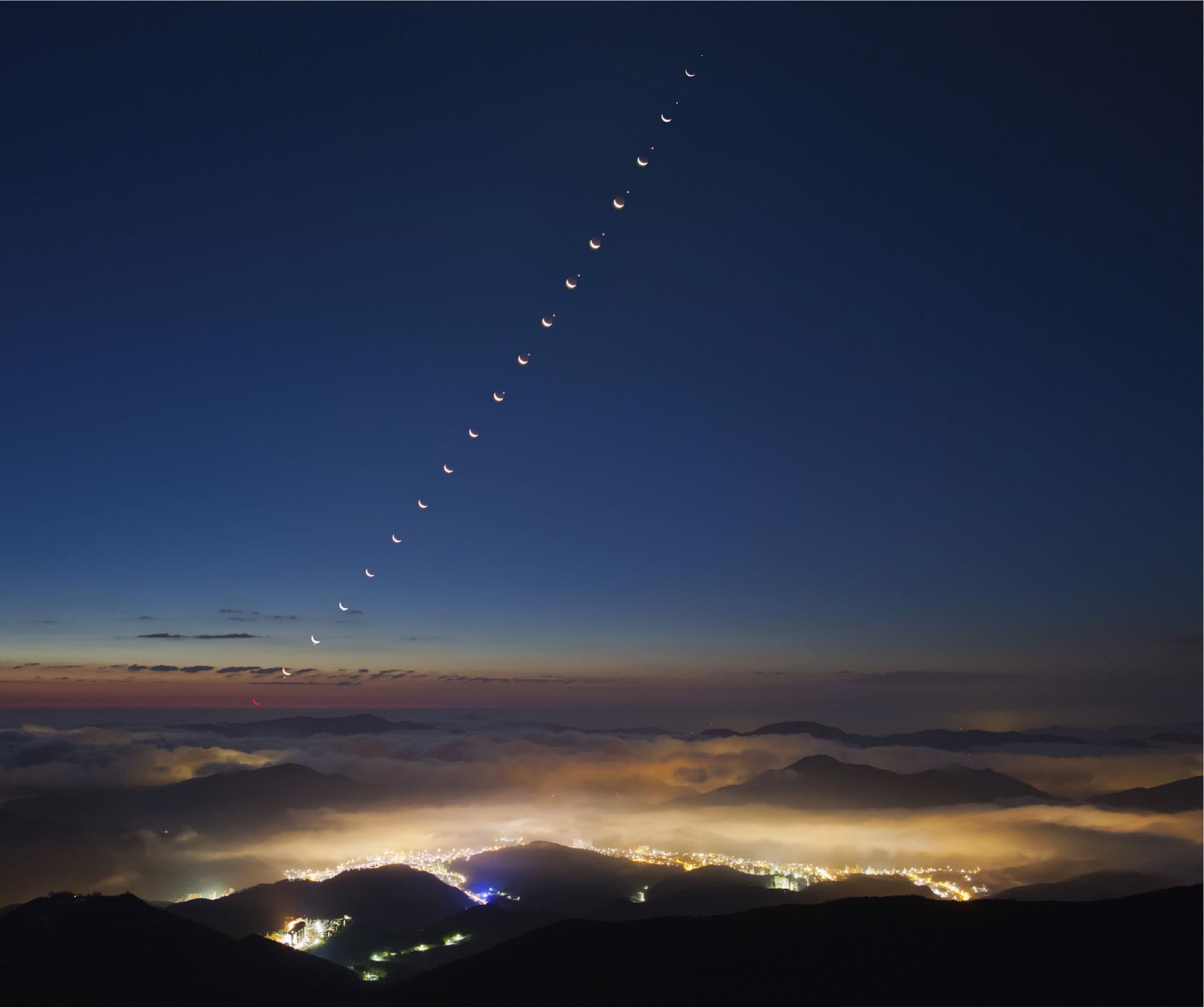
Gangwon Province SOUTH KOREA
Rising in the dark hours before dawn, Venus appears as the morning star in this photo sequence during the moon-Venus conjunction of 13 August 2012. From this location in eastern Asia, a lunar occultation takes place, meaning that the waning crescent moon appears to pass directly in front of the bright planet. The occultation begins near the horizon and progresses as the pair rise. Venus disappears behind the moon’s sunlit crescent, to emerge from the dark lunar limb before dawn. The image is constructed from frames made at ten-minute intervals, and follows the celestial performance from above the city lights and clouds over the city of Taebaek.

Réunion SOUTH INDIAN OCEAN
This triple conjunction of Jupiter, Mars and Venus, together with the moon, was captured on 7 November 2017. In the foreground is a beautiful banyan on Réunion Island. The bizarre-looking tree is the national tree of India, which is home to some of the greatest and oldest specimens.

Cologne GERMANY
A new moon and Venus (lower-right) are captured at dusk on 2 January 2014. Both appear as thin crescents above the World Heritage site of Cologne Cathedral, which stands 157 m (515 ft) tall. When Venus is close to the orbital position between Earth and the sun, it appears as a crescent, large enough to be visible using mid-sized binoculars, a small telescope or a camera with a telephoto lens.

Santiago CHILE
The crescent moon is captured approaching a pair of bright planets, Venus and Jupiter, in the western sky of Santiago de Chile on the evening of 30 November 2008. The planets are only 2 degrees apart in this panoramic image. Despite bright city lights, celestial events that include brighter planets and the moon are often remarkably visible.
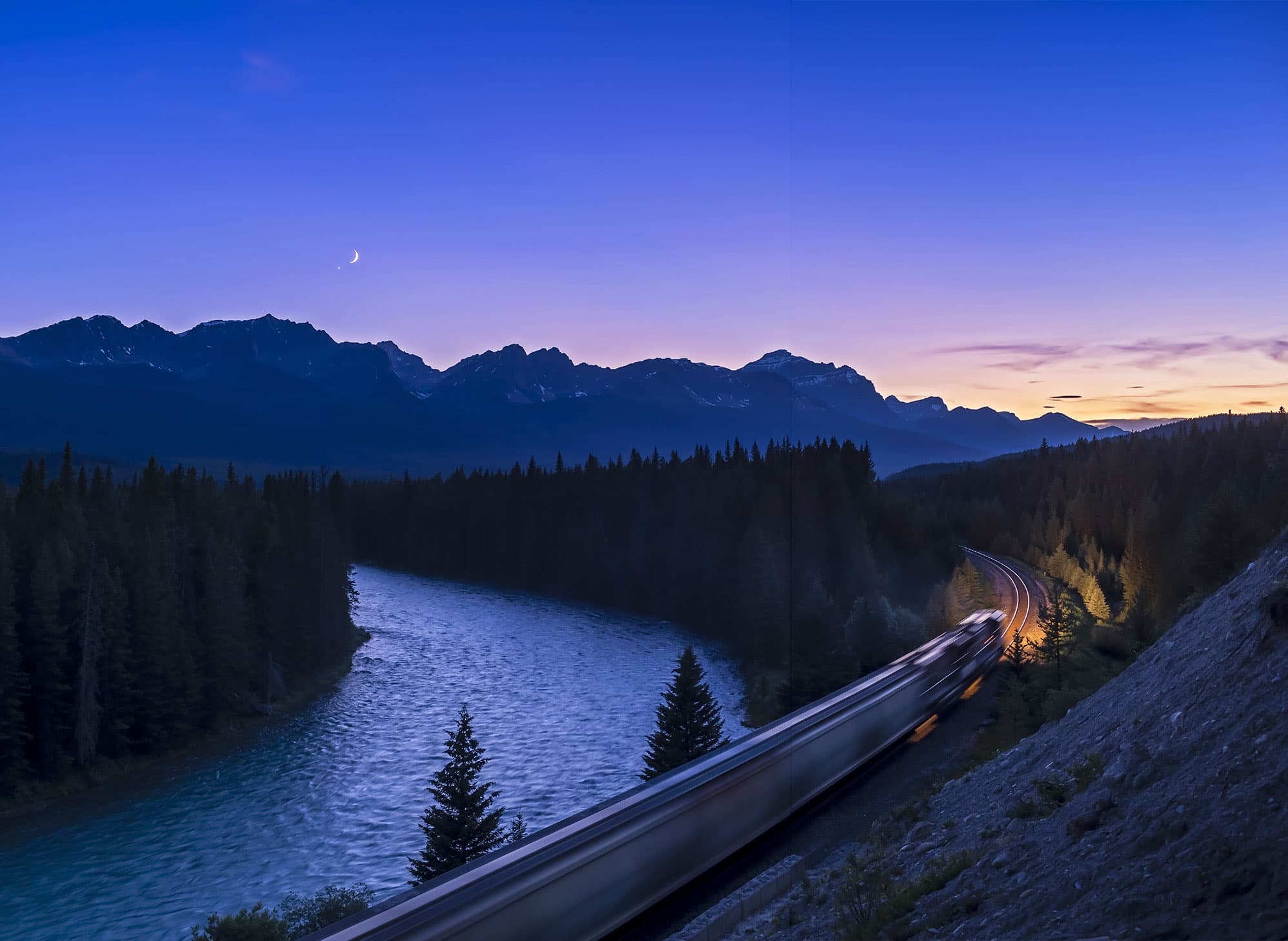
Alberta CANADA
This close conjunction of the crescent moon and Venus occurred on the evening of 15 July 2018. It was taken from Banff National Park, a popular destination for stargazing in Canada. In the foreground is the Continental Divide of the Americas. A westbound train crossing the Bow River is heading in the direction of the divide.
ATMOSPHERIC
We are living through an exciting era of space exploration, allowing us to learn more about the surfaces and atmospheres of other worlds by sending probes to every wonder in the solar system. Yet there are still countless mysteries to unravel below and above our immediate living surface. For example, Earth’s atmosphere fascinates atmospheric scientists and photographers alike. Among the more puzzling phenomena are ‘sprites’, large-scale electrical discharges that occur high above thunderstorm clouds and give rise to a range of visual shapes that flicker in the night sky. Sprites are usually triggered by discharges of positive lightning between an underlying thundercloud and the ground. First photographed in 1989, they appear as luminous, reddish-orange flashes, often occuring in clusters above the troposphere at altitudes of 50–90 km (30–55 miles). Other atmospheric appearances relate to rocket activity. Long-range rockets or satellite launchers leave colourful glowing clouds in the night sky to the surprise of unsuspecting viewers. The re-entry of an old satellite is another wonder to look out for. When they burn in the upper atmosphere, some 100–60 km (60–40 miles) above the surface, they can create a flock of fireballs above certain areas.
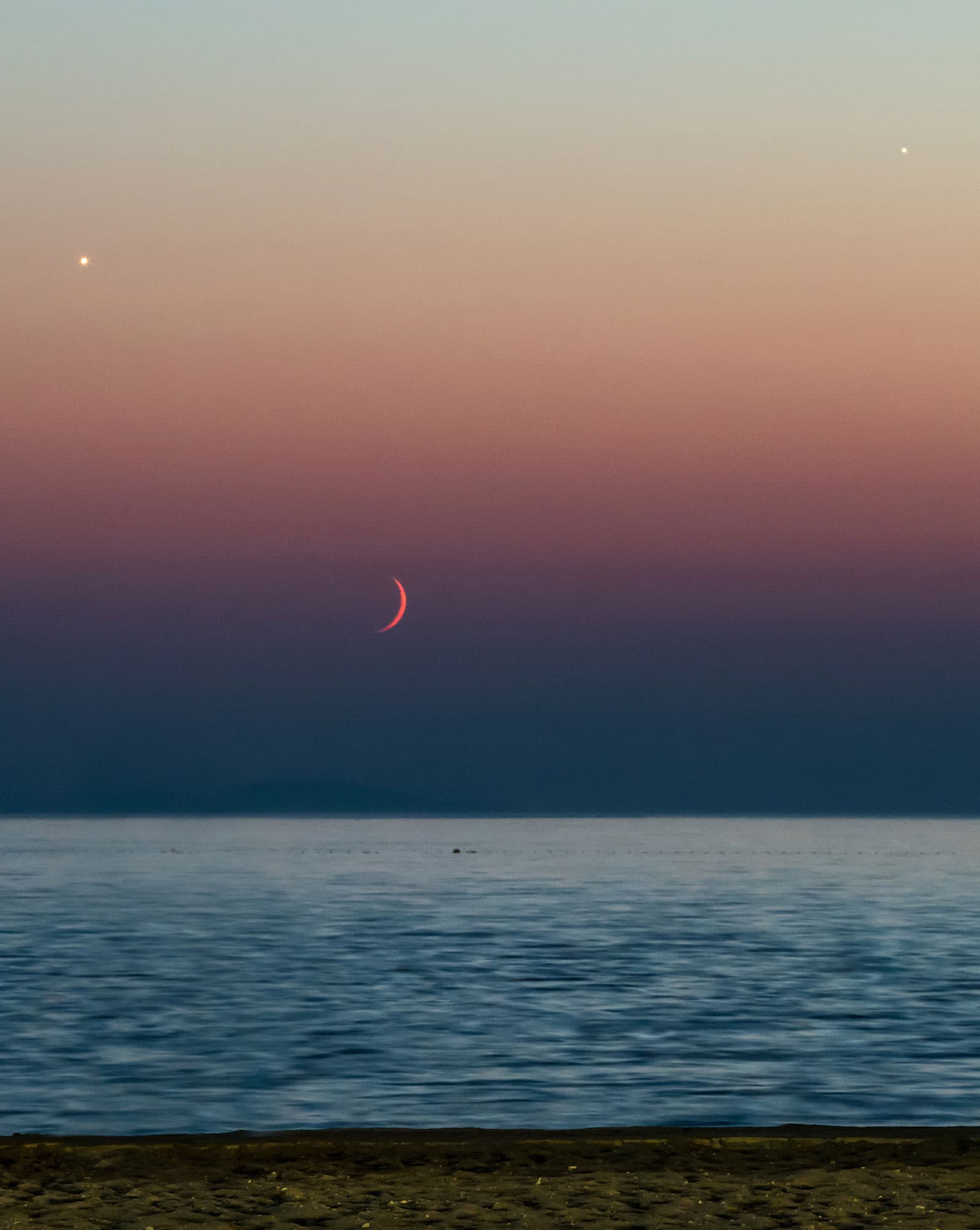
Zaton CROATIA
As dusk colours settle over the Adriatic Sea, the crescent moon, Venus (top-left), and Jupiter (top-right) set above the Croatian coast.
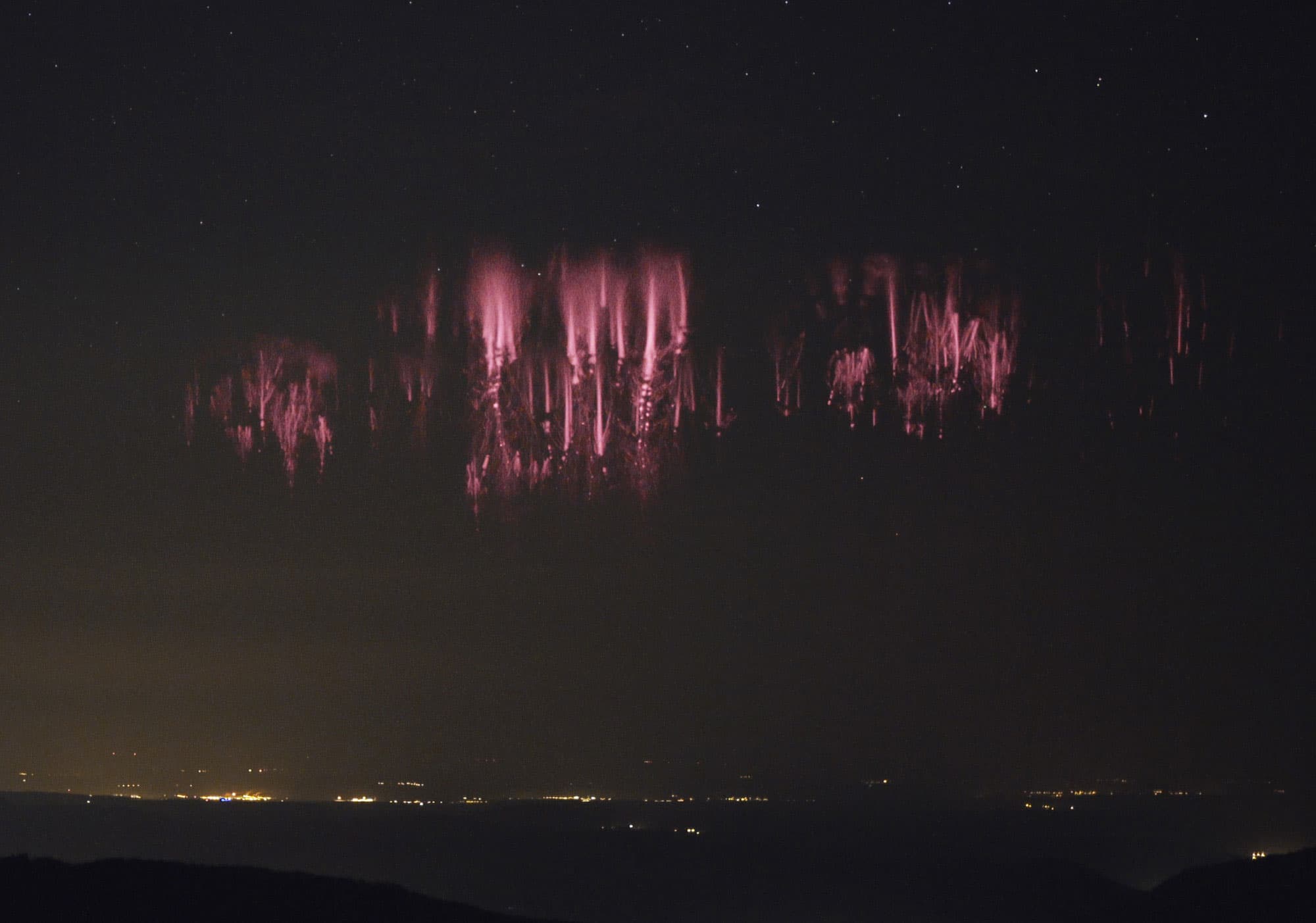
Alsace FRANCE
The rarely seen Red Sprites on a summer’s night in France, these large-scale electrical discharges occur high above thunderstorm clouds. They flash in the sky for a fraction of a second and are much fainter than lightning strikes. The key to seeing and capturing sprites is a combination of a clear sky, with a thunderstorm around 200–300 km (125–185 miles) away.

California USA
At the annual Nightfall Star Party in Borrego Springs, in November 2015, the southwestern sky lit up in a weird glow that surprised the stargazers, as shown in the top image. They learned that the glow had come from a Trident II (D5) missile, which had been test launched from a submarine off the coast of San Diego.
Two years later, on 22 December 2017, a Falcon 9 rocket launch from Vandenberg Air Force Base produced an equally spectacular show above the same location, as shown here.

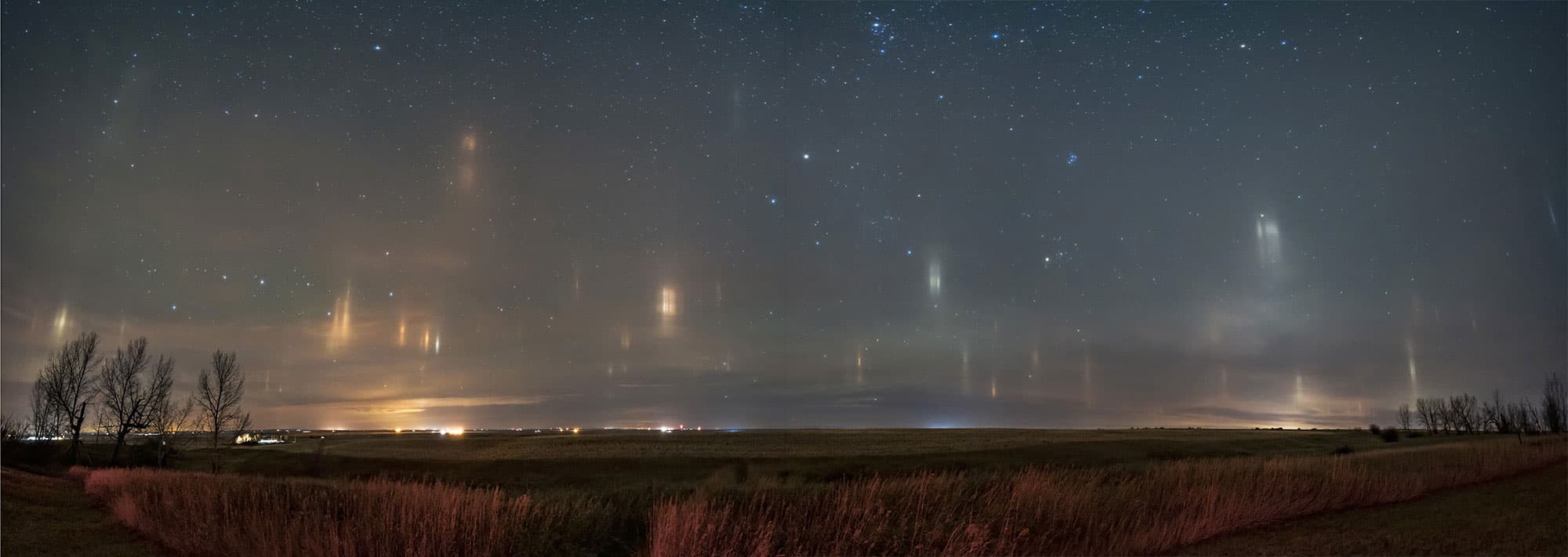
Alberta CANADA
This panorama offers an exceptionally clear view of atmospheric optical phenomena known as ‘light pillars’. Photographed on a cold night in rural Alberta, the sky from north (left) to south is filled with pillars of flat ice crystals hanging in the still air. They reflect the lights below – in this case emanating from farms and gas plants, and from towns in the distance. On this occasion, the effect was short-lived and was over in half an hour. It had snowed earlier in the day and the air was moist, creating enough icy haze and fog to produce the light pillars, but not dense enough to obscure the stars. The Big Dipper and Polaris are to the left. Auriga, Taurus and the Pleiades cluster are rising centre right.
AURORA STORM
Witnessing an aurora when a solar flare creates a geomagnetic storm around the planet can be a lifetime’s experience. At such times, an aurora crown forms overhead, appearing to boil with motion and colour across the entire spectrum. Such a phenomenon dominates the entire sky, illuminating the surrounding landscape and casting shadows. It is less colourful to the naked eye than it is to a camera, as the human eye’s colour-detecting cones need more light for activation. Intensity varies in each person, too. Green is usually the first discernable colour, with red and purple being the next, followed by blue, although this is rare. The activity level is measured by something called a Kp index: 0 to 3 is weak to regular and only visible from polar latitudes; 4 to 5 indicates a semi-storm and is visible as low as 55 degrees magnetic latitude; above 6 promises a major show; 8 to 9 is visible from surprisingly low latitudes.
During an Earth-directed solar flare – usually generated by a large active sunspot – a massive stream of high-energy charged particles are ejected from the sun’s magnetic field and into the solar wind. It’s difficult for scientists to predict whether or not the stream will hit Earth’s magnetic field. Should this happen, however, particles reach Earth within around two days, starting an aurora show that can last anything from just a few hours up to several nights. They are best witnessed from high latitudes.
On average, and with dark skies, these events are strong enough to appear on the northern horizon once a year, at such low latitudes of 30–35 degrees in North America. This is because the location is directly beneath the North Geomagnetic Pole. In Europe, events will occur 5–10 degrees higher. Moving away from the North Geomagnetic Pole, in the eastern hemisphere, an observer should be even higher to see a glimpse of these lights (this is reversed in the southern hemisphere).
The most intense geomagnetic storms have been reported as a red glow even from the tropics. The 1958 extreme aurora was seen from Mexico City. The most potent recorded storm occured in 1909, and was seen from Singapore at the equator. These superstorms often occur close to the peak of the eleven-year solar activity cycle – next expected between 2024 and 2026.
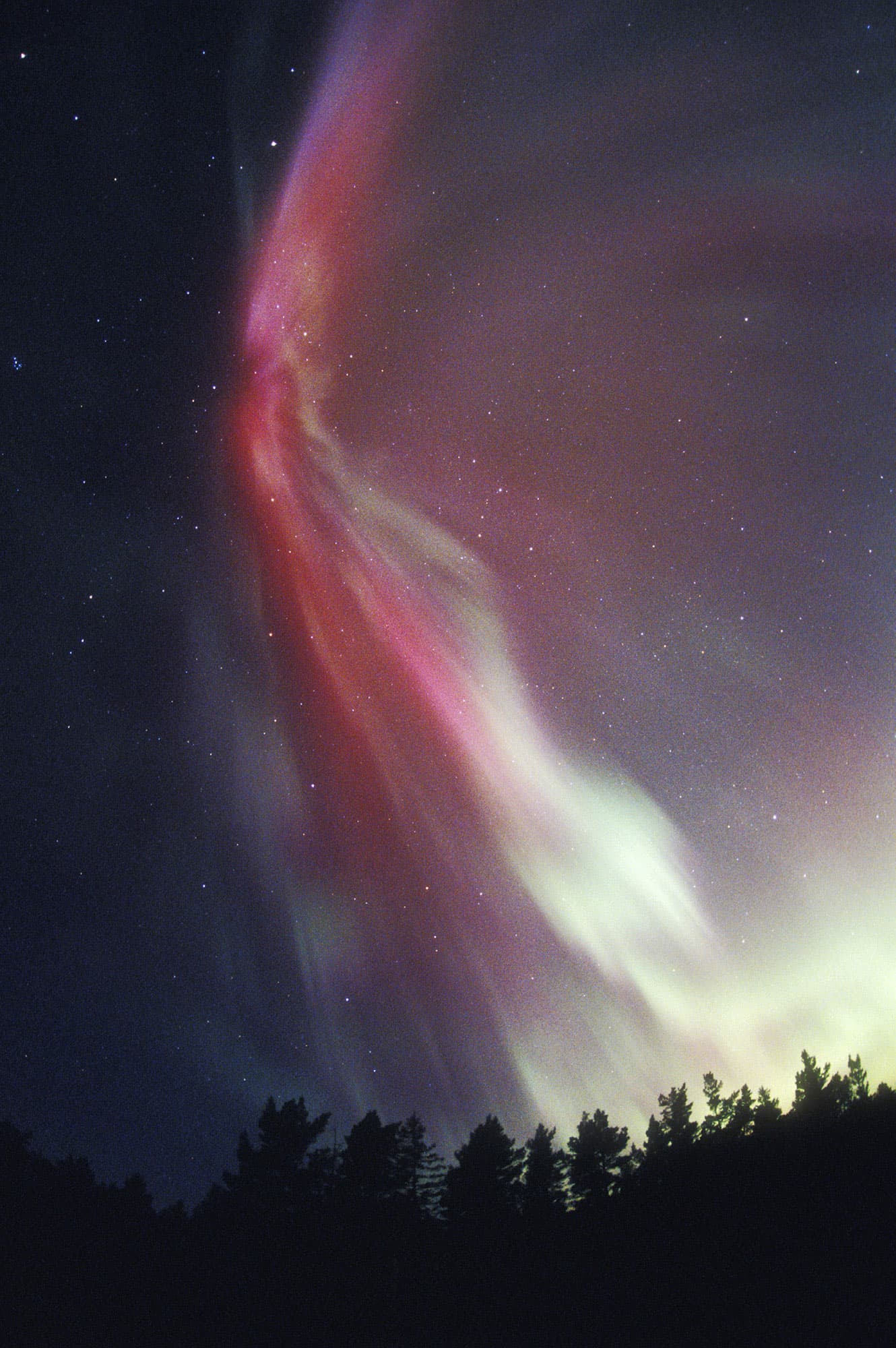
Uusimaa FINLAND
A strong aurora storm resembles a standing red queen in the sky. This natural display is produced when charged particles from the sun – mostly electrons but also protons and heavier particles – become trapped in Earth’s magnetosphere, colliding with atoms and molecules at altitudes above 80 km (50 miles).

Snaefellsnes Peninsula ICELAND
One of the strongest aurora storms of the past two decades was caused by a solar eruption that impacted on Earth on 17–18 March 2015. Here, the Northern Lights appear in a range of pastel colours above the iconic Icelandic landmark that comprises the miniature waterfalls and coastal mountain of Kirkjufell (Church Mountain).
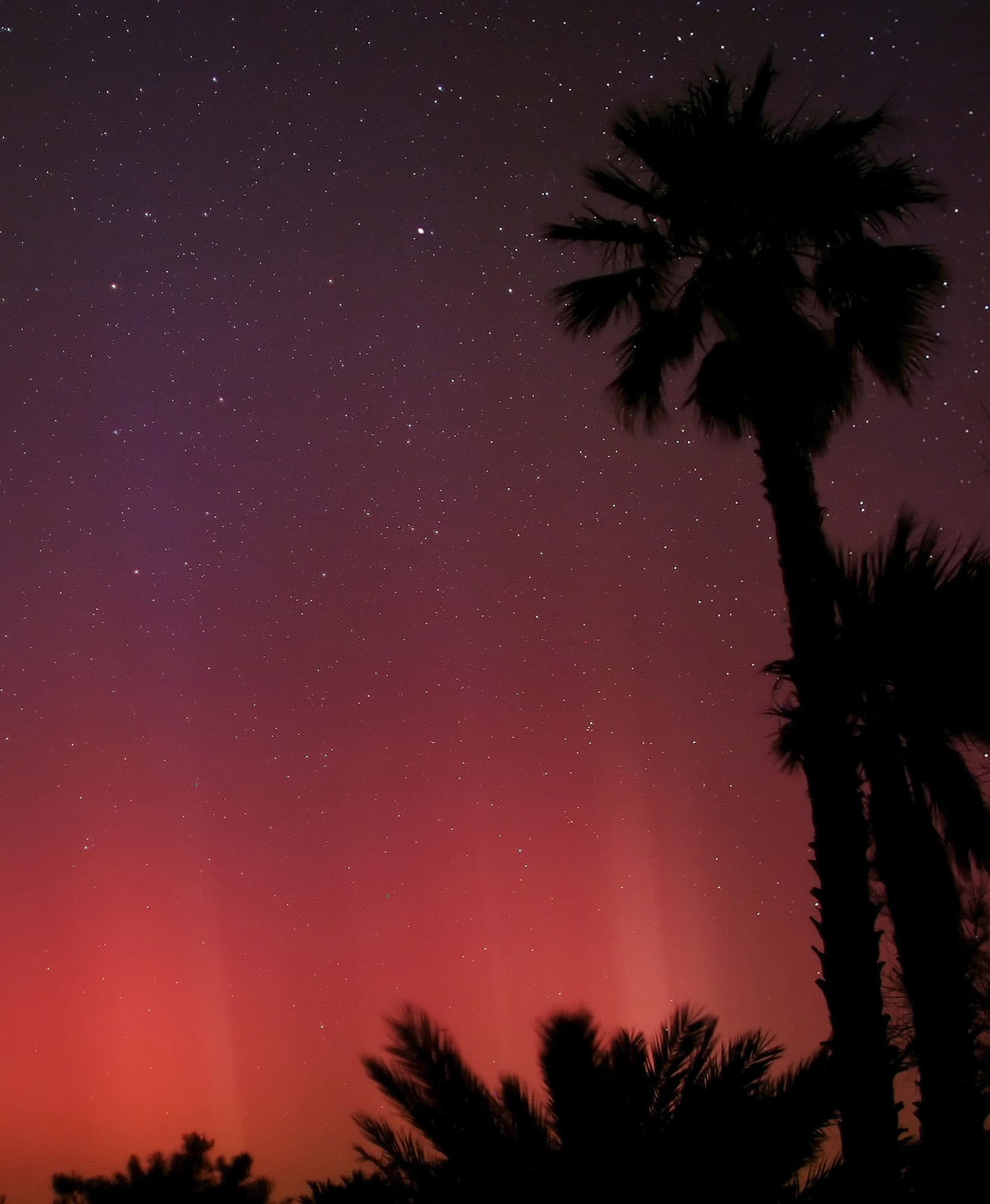
Southern California USA
This is one of very few images of an auroral display behind palm trees, captured when an extremely strong aurora storm on 14–15 May 2005 sparked displays as far south as the Anza-Borrego Desert State Park near San Diego. The event was rather colourless to the naked eye, but not to the camera. The bright star visible centre top is Polaris, at an altitude of 33 degrees. This shows how high the aurora display appeared on this night.

Victoria AUSTRALIA
A sudden red burst of aurora australis, the Small Magellanic Cloud and Comet Lemmon (C/2012 F6), captured on 17 February 2013. This timely image, taken from the southeastern shore of Australia, also shows a green cast of airglow. You can spot the comet with its faint thin tail and green coma at the centre top of the image.